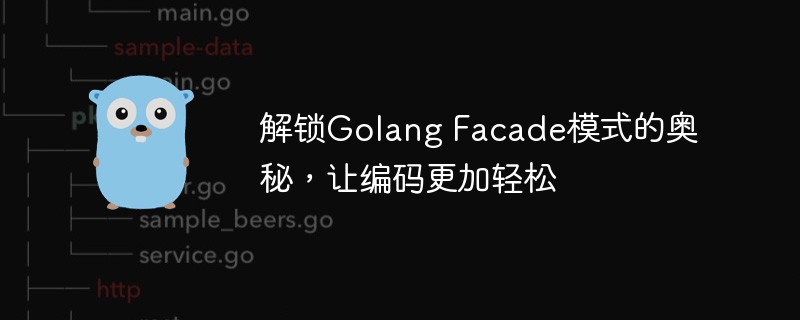

Unlock the secrets of Golang Facade mode and make coding easier
Introduction:
In software development, we often encounter multiple complex problems in a system subsystems, and we need to provide a simplified interface to the outside world to access these subsystems. At this time, the Facade mode can come in handy. The Facade pattern encapsulates complex subsystems by providing a unified interface, allowing clients to use these subsystems more easily.
This article will introduce how to apply the Facade pattern in Golang, explain its principles and applications through specific code examples, and help readers better understand and use this pattern.
Background:
Suppose we want to write a facade pattern for an order management system. The order management system has the following complex subsystems: inventory management, payment management and logistics management. In order to allow clients to conveniently operate these subsystems, we will use the Facade pattern for encapsulation.
Code implementation:
First, we need to define the interfaces of the three subsystems and implement specific functions in each subsystem. Taking inventory management as an example, the code is as follows:
type InventoryManager interface {
CheckStock(productId int) bool
ReduceStock(productId int, quantity int) bool
}
type InventoryManagerImpl struct {
// 具体的库存管理实现
}
func (i *InventoryManagerImpl) CheckStock(productId int) bool {
// 检查库存是否足够的具体实现
}
func (i *InventoryManagerImpl) ReduceStock(productId int, quantity int) bool {
// 减少库存的具体实现
}Next, we define a facade interface to encapsulate the specific calling methods of these three subsystems. The code is as follows:
type OrderFacade interface {
CheckStock(productId int) bool
PlaceOrder(productId int, quantity int) bool
CancelOrder(orderId int) bool
}
type OrderFacadeImpl struct {
inventoryManager InventoryManager
paymentManager PaymentManager
logisticsManager LogisticsManager
}
func (o *OrderFacadeImpl) CheckStock(productId int) bool {
// 调用库存管理子系统的具体方法
return o.inventoryManager.CheckStock(productId)
}
func (o *OrderFacadeImpl) PlaceOrder(productId int, quantity int) bool {
// 调用库存管理、支付管理和物流管理子系统的具体方法
if o.inventoryManager.CheckStock(productId) {
if o.paymentManager.Pay(productId, quantity) {
if o.logisticsManager.Ship(productId, quantity) {
return true
}
}
}
return false
}
func (o *OrderFacadeImpl) CancelOrder(orderId int) bool {
// 调用支付管理和物流管理子系统的具体方法
if o.paymentManager.Refund(orderId) {
if o.logisticsManager.CancelShip(orderId) {
return true
}
}
return false
}Next, we need to implement specific subsystems, namely payment management and logistics management. The code is as follows:
type PaymentManager interface {
Pay(productId int, quantity int) bool
Refund(orderId int) bool
}
type PaymentManagerImpl struct {
// 具体的支付管理实现
}
func (p *PaymentManagerImpl) Pay(productId int, quantity int) bool {
// 支付的具体实现
}
func (p *PaymentManagerImpl) Refund(orderId int) bool {
// 退款的具体实现
}
type LogisticsManager interface {
Ship(productId int, quantity int) bool
CancelShip(orderId int) bool
}
type LogisticsManagerImpl struct {
// 具体的物流管理实现
}
func (l *LogisticsManagerImpl) Ship(productId int, quantity int) bool {
// 发货的具体实现
}
func (l *LogisticsManagerImpl) CancelShip(orderId int) bool {
// 取消发货的具体实现
}Finally, we can use these subsystems through the facade, simplifying the client code. The code is as follows:
func main() {
orderFacade := &OrderFacadeImpl{
inventoryManager: &InventoryManagerImpl{},
paymentManager: &PaymentManagerImpl{},
logisticsManager: &LogisticsManagerImpl{},
}
// 检查库存是否足够
if orderFacade.CheckStock(1001) {
// 下订单
if orderFacade.PlaceOrder(1001, 1) {
// 取消订单
if orderFacade.CancelOrder(10001) {
fmt.Println("订单已取消")
} else {
fmt.Println("取消订单失败")
}
} else {
fmt.Println("下订单失败")
}
} else {
fmt.Println("库存不足")
}
}Summary:
Through the above examples, we can see that through the Facade mode, we encapsulate complex subsystems and provide a unified interface for the client to use. The client can more easily call the functions of these subsystems. At the same time, through encapsulation and abstraction, we enable subsystems to evolve independently without affecting the client's calling code.
I hope that through the introduction of this article, readers can understand and master the usage and principles of Facade mode in Golang, so that they can use this mode more flexibly in actual development.
The above is the detailed content of Unlock the secrets of Golang Facade mode to make coding easier. For more information, please follow other related articles on the PHP Chinese website!




